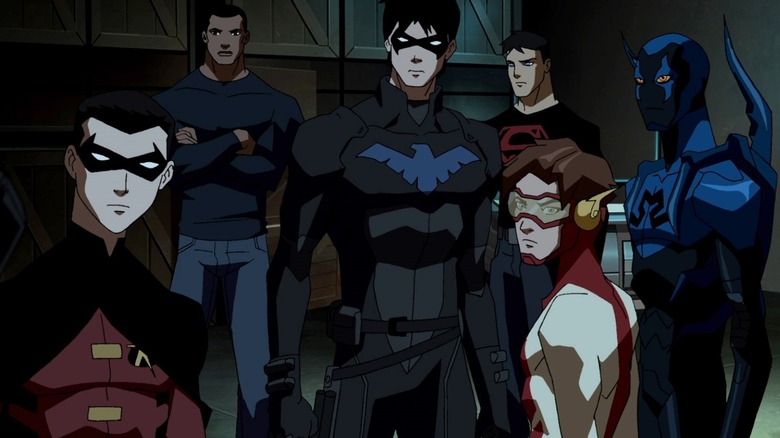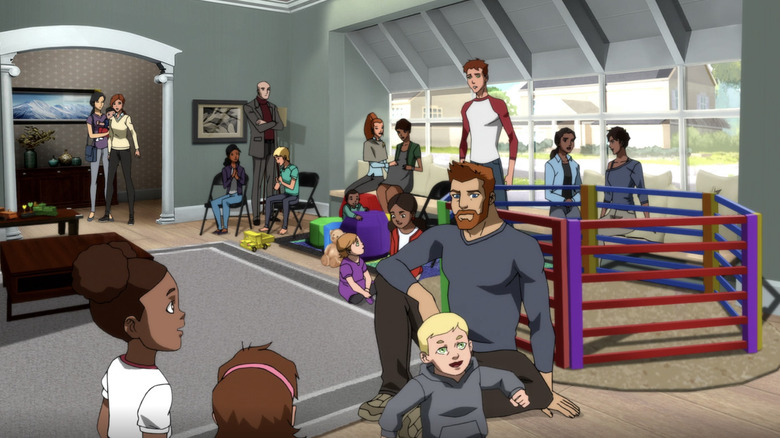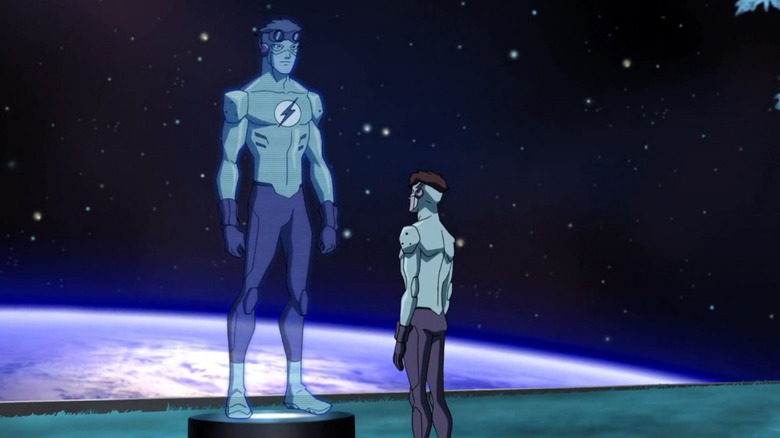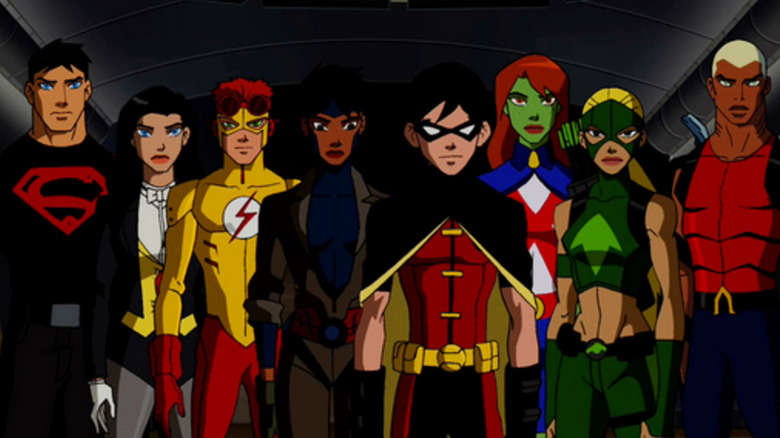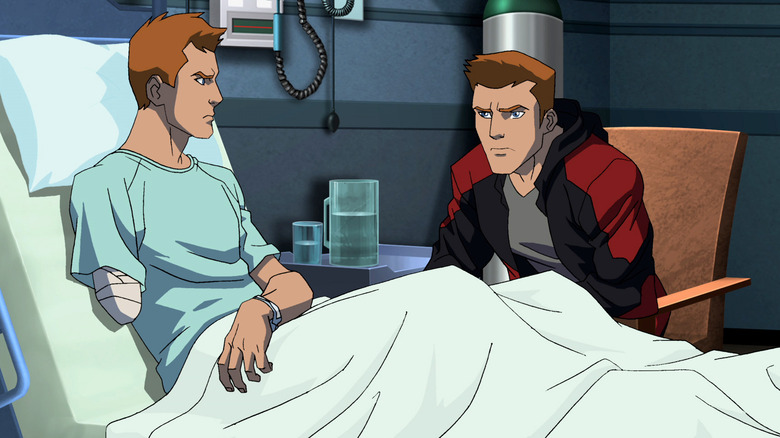How Young Justice Cracked The Formula And Made The Best Superhero Show Out There
We've seen the rise of superhero universes with large ensembles and interconnected stories, whether it's the Arrowverse on TV or the Marvel Cinematic Universe on the big screen. But a problem with these expansive universes is that they have to make the individual stories matter as much as the team-ups, without relying on multiple characters appearing in every single entry.
The animated "Young Justice" is one of the few superhero shows that cracks the code to this problem, making a serialized story with an overarching plot that introduces consequences to the heroes' actions while managing a large ensemble of characters both iconic and under-seen — all while also exploring the idea of legacy and identity across a long period of time.
With the second half of its fourth season returning this week on HBO Max, there's never been a better time to catch up on, or start watching this show.
It shares the spotlight
From the very first episode, it is clear that "Young Justice" is showing us but a small fraction of a much larger superhero universe, where each character has their own long history. Along the way, we are introduced to more and more characters, with the Justice League adding five members by the end of the first season, while the second season doubles the size of The Team (which yes, is the name of the show's main superhero group).
More importantly, these characters are not just ones we've seen in major shows or movies before. Instead, the show often gives the spotlight to characters from across the DC multiverse that have never been adapted to the screen before, like Lagoon Boy, Miss Martian, Icon, Rocket, Impulse, and more. With these additions to The Team comes the difficulty of giving them screen time each episode, and the show's answer quickly becomes its secret weapon: it constantly changes the roster and focuses on different characters. Because of this, "Young Justice" can build a connected and expansive universe with dozens of small teams, each of them with its own storylines that gradually build to a massive conclusion that involves them all.
"Young Justice" intentionally sidelines, retires, or uplifts characters that it focuses on, preventing the show from ever having a status quo that can grow scale. And when we finally catch up with older characters, we see how much they've grown and changed in more exciting and surprising ways than if we were following them every single episode with only gradual change. In season 2, Kid Flash and Artemis retire and go to college, and we see how their actions in the first season have inspired a new generation of kids to become heroes in their own right. The feeling of not knowing where a certain character is at times, only for them to come back when duty calls, makes the world feel bigger and closer to the experience of actually reading comic books.
Season 3 even introduces the first generation of kids born from superheroes, like The Flash's twin children, Rocket's son, and of course, Lois Lane and Superman's son Jonathan. Damian Wayne is also teased throughout the season. Nothing is permanent in this show, and anything can and does change, including the mantles of your favorite heroes.
Anyone can wear the mask
While the concept of legacy and mantles being passed from one person to another is essential to superhero comics, we've barely seen it be explored on the screen. We've only really seen a hero taking up the mantle of a former superhero in "Spider-Man: Into the Spider-Verse" and then in "The Falcon and the Winter Soldier."
But "Young Justice" has been dealing with this idea from the very beginning. Characters retire or die, and others pick up their title and bring their own spin on the mantle. We've seen Robin become Nightwing, and Tim Drake becomes the new Robin (after Jason Todd's off-screen death), while the titles of Aquaman and Kid Flash have been bestowed upon new heroes.
This helps not only sell the idea that time doesn't stop moving, and nothing is permanent in this world. It also makes each hero feel more important, because their actions continue to inspire others to do good even after death or retirement.
It has consequences
The animated format could easily allow the writers to keep the characters in stasis as perpetual teens. But using the real-world passage of time allows "Young Justice" to show the growth of the characters and to give weight to their actions. And I don't just mean in terms of death, but in seeing characters live with what they've done.
Because the show skips forward in time each season, it allows us to see how early decisions and missions affect the characters in deep ways. In season 1, Robin and Speedy struggle with the idea of being sidekicks and living in the shadow of famous heroes. By season 2, Robin — now Nightwing — finds himself becoming more and more like the detached and calculating Batman he once criticized, forced to sacrifice the emotional well-being of his friends for the sake of a mission. At the same time, Speedy — now Red Arrow — does on a spiral of depression after discovering he's a clone of the original Roy Harper.
Now in season 4, it's been 10 years since the formation of The Team, and we're seeing how time has treated the original members — which have been out of the spotlight for two seasons. We see how the years of losses, grief, lies, and deception has made characters like Nightwing, Miss Martian, Aqualad, and Superboy as seasoned as the Justice League was when the show began, and it can be heartbreaking to see them deal with regret.
It isn't afraid to make its own canon
Of course, condensing 84 years of superhero history into a single TV show means making some changes to the canon, and "Young Justice" excels at making enough changes to the canon to stay fresh, surprising, and to serve its own universe.
Take the aforementioned clone of Roy Harper, the earliest twist in the show. It was a way for the show to have its cake and eat it too, having both Red Arrow and Arsenal at the same time rather than wait for Roy Harper to grow old and change his name. But it also served as an emotional, impactful story that affected all the characters and continues to have ripples even 10 years in.
The same happens this season when the show retcons the story of Batgirl becoming Oracle into something new that also strengthens her relationship with the Bat-family, or even when we get a new backstory for Doctor Fate which is tied to the entire history of the DC universe. These changes may anger ardent defenders of the canon, but they make this show feel unique and surprising even after 10 years.
